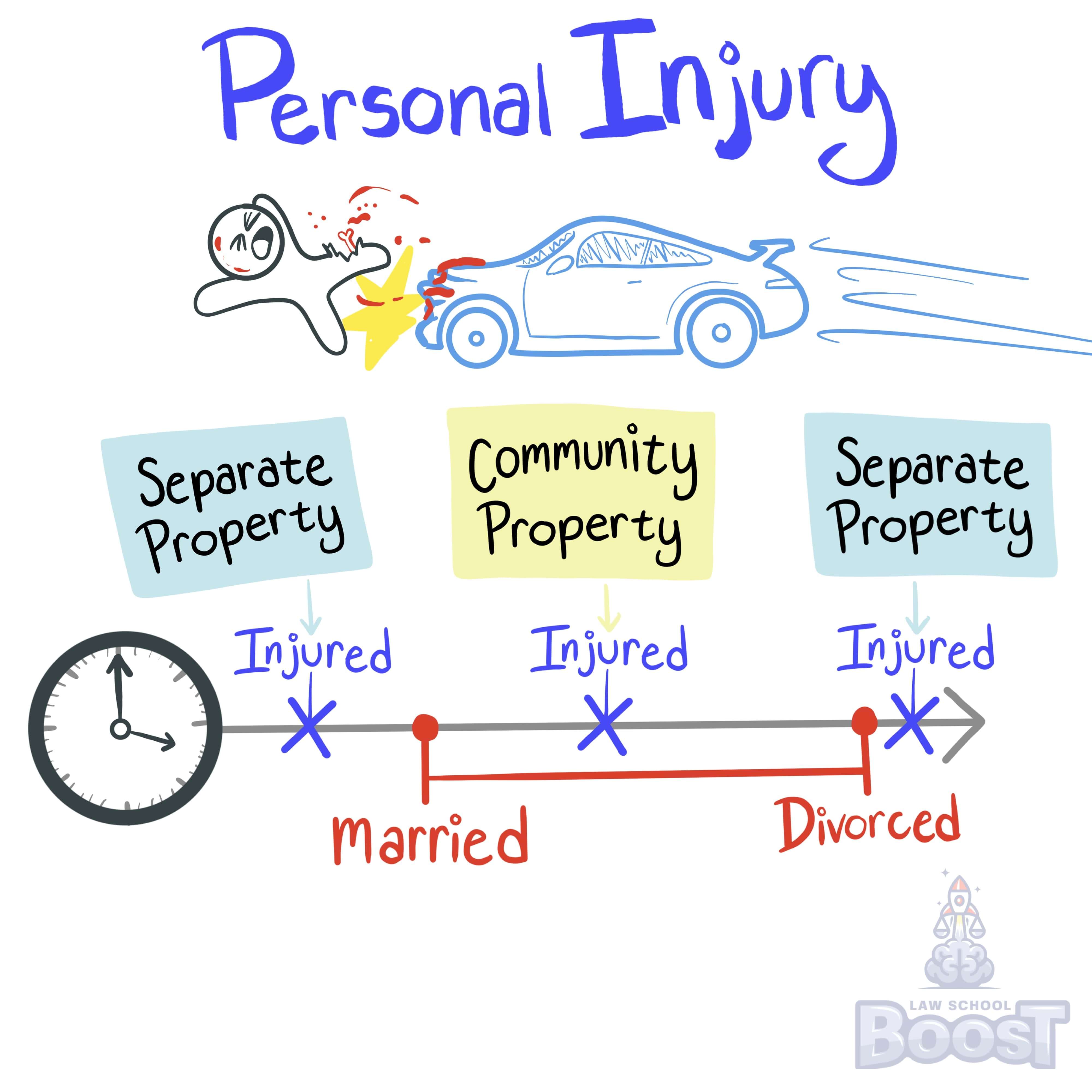🤧
Community Property • Personal Injury Damages
CPROP#019
Legal Definition
Personal injury damages are treated differently depending on when they occurred—community property if the personal injury cause of the action arises during marriage, and separate property if before marriage or after marriage/permanent separation. For divorce purposes, community personal injury damages are awarded entirely to the injured spouse (so long as they can be traced, unless the interests of justice require otherwise. Upon death, however, such damages are treated as community property. If either spouse is the tortfeasor, the recovery to the non-tortfeasor is separate property.
Plain English Explanation
Money received for personal injuries is treated based on when the injury happened. If someone got hurt during their marriage, any money awarded for that injury is shared property of both spouses. If the injury happened before they were married or after they split up, the money generally belongs only to the person who was hurt. If they divorce, the injured spouse usually gets all the injury money (if it's possible to find that money and trace it back to the judgment award, which means being confident in the ability to identify the specific money from the judgement and not unrelated money that may share the account), unless fairness dictates otherwise. However, if one spouse passes away, that injury money is considered shared property if it was irretrievably commingled with the community property. If a spouse causes the injury, then the money received by the other spouse is solely theirs.
Hypothetical
Hypo 1: Bob and Amy are happily married. During their marriage, Bob is involved in a car accident and receives a large settlement for his injuries. Result: Since Bob received the personal injury settlement during the marriage, the money is considered community property. However, upon divorce, it is generally awarded to Bob, the injured spouse, unless fairness dictates otherwise.
Hypo 2: Amy was injured in a workplace accident just a few weeks before her marriage to Bob. She receives a compensation settlement after they are married. Result: The compensation Amy receives is her separate property, as the injury occurred before the marriage.
Hypo 3: After Bob and Amy divorce, Bob is injured in a biking accident and receives a settlement. Result: The settlement Bob receives is his separate property since the injury and the settlement occurred after the divorce.
Hypo 4: During their marriage, Bob injures Amy in an argument, and Amy receives a settlement for her injuries. Result: The settlement money Amy receives is considered her separate property because Bob, her spouse, was the one who caused the injury.
Hypo 5: Amy receives a $50,000 personal injury settlement during her marriage to Bob. She decides to keep this money separate by placing it into an individual savings account that she does not touch. Over the years, the account accrues interest. During their divorce, Bob claims a share of the total amount in the account. Result: The initial $50,000 from the personal injury settlement is easily traced back to Amy's settlement and remains her separate property. However, the interest earned on that amount is considered community property and is subject to division between Amy and Bob.
Hypo 6: During her marriage, Amy wins $100,000 in a personal injury lawsuit. She deposits this amount into the couple's joint checking account, which they use for various household expenses. Over the years, the balance fluctuates as they deposit paychecks and pay bills. When they divorce ten years later, the account has a balance of $20,000. Result: Tracing the $100,000 personal injury settlement becomes extremely difficult due to its commingling with community funds in the joint account. It's near impossible to distinguish what portion of the current balance directly relates to Amy's original settlement. Therefore, the $20,000 in the account is likely treated as community property, to be divided between Amy and Bob.
Hypo 2: Amy was injured in a workplace accident just a few weeks before her marriage to Bob. She receives a compensation settlement after they are married. Result: The compensation Amy receives is her separate property, as the injury occurred before the marriage.
Hypo 3: After Bob and Amy divorce, Bob is injured in a biking accident and receives a settlement. Result: The settlement Bob receives is his separate property since the injury and the settlement occurred after the divorce.
Hypo 4: During their marriage, Bob injures Amy in an argument, and Amy receives a settlement for her injuries. Result: The settlement money Amy receives is considered her separate property because Bob, her spouse, was the one who caused the injury.
Hypo 5: Amy receives a $50,000 personal injury settlement during her marriage to Bob. She decides to keep this money separate by placing it into an individual savings account that she does not touch. Over the years, the account accrues interest. During their divorce, Bob claims a share of the total amount in the account. Result: The initial $50,000 from the personal injury settlement is easily traced back to Amy's settlement and remains her separate property. However, the interest earned on that amount is considered community property and is subject to division between Amy and Bob.
Hypo 6: During her marriage, Amy wins $100,000 in a personal injury lawsuit. She deposits this amount into the couple's joint checking account, which they use for various household expenses. Over the years, the balance fluctuates as they deposit paychecks and pay bills. When they divorce ten years later, the account has a balance of $20,000. Result: Tracing the $100,000 personal injury settlement becomes extremely difficult due to its commingling with community funds in the joint account. It's near impossible to distinguish what portion of the current balance directly relates to Amy's original settlement. Therefore, the $20,000 in the account is likely treated as community property, to be divided between Amy and Bob.
Visual Aids



